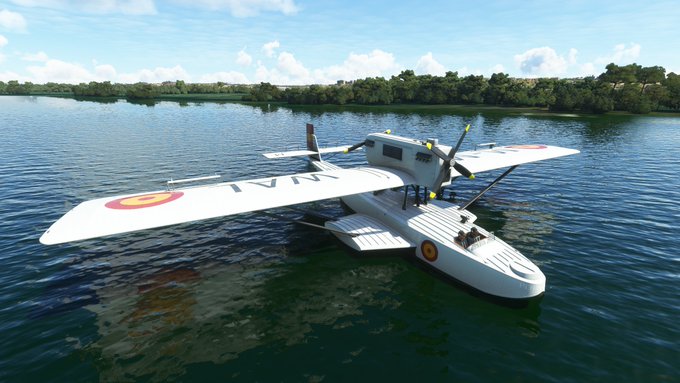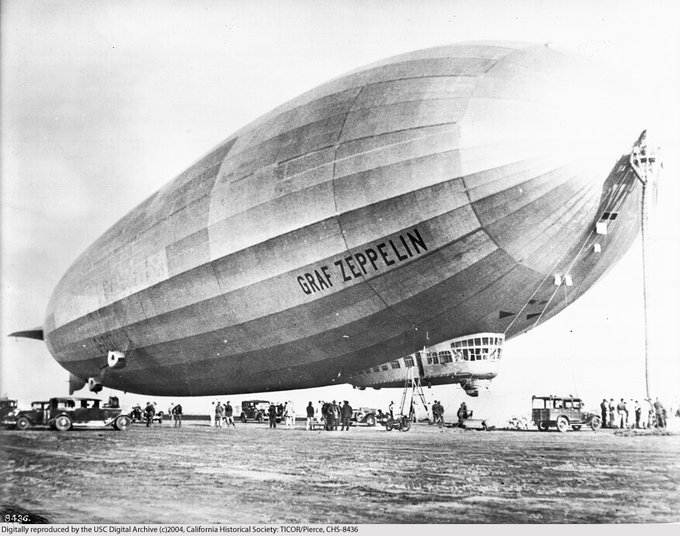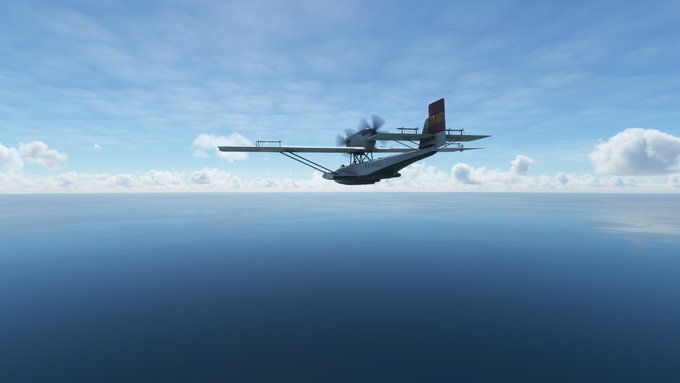December 13, 2022
Today in Microsoft Flight Simulator, I’m going to be flying an airplane that played an important but often forgotten role in the early history of aviation, the Dornier Do J “Wal”.

Claude Dornier, born in 1884, was the son of a French wine merchant and his German wife. He grew up in Bavaria and graduated from engineering school in Munich.

He went to work for Ferdinand von Zeppelin at his base in Friedrichshafen, and soon rose to become the Count’s top technical advisor, helping design dirigibles and airplanes.

n 1914, Dornier formed his own airplane company, also based in Friedrichshafen. A museum is located on the site today.

After its defeat in World War I, all aircraft production in Germany was prohibited. Dornier continued to design aircraft, but had to produce them in Italy. The Dornier Do J flying boat was his first major success.

The Do J was powered by two piston engines placed in tandem (front and back) over the wing. A variety of different types of engines were used, depending on availability and needs. These are British-made Napier Lion 12-cylinders, putting out 450hp each.

The floats on either side of the fuselage, supporting the wing struts, are Dornier’s patented “sponsons”, which made it more stable in the water than the more common side pontoons.

As you can see, the engines were accessible via a ladder, on the platform behind the cockpit.

A look inside the compartment between the two engines.

The cockpit itself was completely open and exposed to the elements. Keep this in mind on the long journey ahead.

Here’s an interior view of the cockpit. Note the mechanic wires and pulleys connecting the controls to the control surfaces. The instrument panel, directly behind the “wheel”, can be a bit difficult to see.

The main pilot’s seat is on the right, not the usual left. The throttle and fuel mixture levers for both engines are to the pilot’s right side.

Sitting in the cockpit, that big propeller is turning right above your head. (The little fan below it, I’m guessing, drives the airspeed indicator. Tell me if I’m wrong).

The ailerons and elevators both have interesting levered control mechanisms.


The Dornier Do J had its maiden flight in 1922. The nickname “Wal” means “whale”.

The specific airplane we’re looking at right now was called the “Plus Ultra”. And we’re joining it just as it prepares to take off from the Rio Tinto in front of Palos de la Frontera, in southern Spain, for a historic flight on January 22, 1926.

The pilot was Captain Ramon Franco, brother of future Spanish dictator Francisco Franco. Both were officers in the Spanish army, though in 1920 Ramon had joined the country’s new Air Force.

The co-pilot was Captain Julio Ruiz de Alda, who later helped found Spain’s fascist Falangist movement, and was executed by anarchists in the Spanish Civil War.

We’re up and going. There were also two more crew members, a lieutenant and a mechanic, who I presume were located inside the hull.

Their goal was to fly from Spain across the South Atlantic to Buenos Aires in Argentina, in a series of stages. Their point of departure, Palos de la Frontera, was symbolic because it is where Columbus sailed from on his first voyage to the Americas.

Rio Tinto, of course, is also the name of a large British mining company that operated the famous copper mines here, just outside of Huelva, starting in the late 1800s. These were their loading piers, below me.

By the bridge, just below the electrical pylons, at the very tip of the peninsula where the rivers converge, you can see the monument to Columbus’ voyages.

Ahead of me, flying south, is the modern beach resort of Punta Umbria, and beyond it, the Gulf of Cadiz.

Checking the magnetic compass next to my seat to make sure I’m flying in the right direction.

“Plus Ultra” means “further beyond” in Latin, and is the national motto of Spain.

The first leg of this journey was 1,300km to the Canary Islands, all by sea.

Of course, weight is everything on a journey like this. Before departing Spain, they actually a discovered a stowaway on board – a newspaper reporter – who could have ruined their plans.

The journey to the Canary Islands took 8 hours. Consider, that’s an awfully long time to be in an open cockpit, completely exposed to the elements, over the ocean.

The Canary Islands, straight ahead.

Flying over the port of Las Palmas de Gran Canaria.

The Plus Ultra landed a bit further south along the shore, at the Bay of Gando.

Today, that’s where Gran Canaria’s international airport is located.

Coming down for a landing in the Bay of Gando, Gran Canarias.

On the 26th, they took off from Gran Canaria on the second leg: 1,745km to Cabo Verde, off the western tip of Africa.

This time, the journey last 9 hours and 50 minutes over the ocean, before reaching land.

Arriving at Praia, at Cabo Verde, just as the sun is setting.

An interesting thing about seaplanes, then and now, is that their pilots have to know the traffic rules for airplanes AND for ships.

Docked for the night in the harbor at Praia, on Cabo Verde.

Taking off from Cabo Verde for the third and longest stage, across the Atlantic to Brazil.

On this leg, the Plus Ultra ran into serious headwinds that slowed its progress considerably and pushed it off course.

Almost out of fuel, they fortunately came across the tiny islands of Fernando de Noronha, 350km off the northeast tip of Brazil.

It must have been an extremely welcome sight.

Today the islands are still very remote and mainly popular for ecotourism.

They had traveled 2,305km in 12 hours and 40 minutes.

I have no idea how they got refueled here, but somehow they did, and by January 31 were ready to depart on their next stage.

You’d think that the next leg, 540km to Recife on the mainland coast of Brazil, would be easy by comparison.

In fact, the rear propeller broke and had to be fixed in mid-flight. Unless they landed in the ocean, I assume they had the mechanic climb up there while still in the air. I tried it, and the plane can still fly on one engine – barely.

After 3 hours and 38 minutes, though, they made it safely to Recife.

From here it was a matter of following the coast for 2,100km to Rio de Janeiro, which took 12 hours and 15 minutes. They arrived in Rio to a rapturous welcome on February 4.

The crew of the Plus Ultra were not, in fact, the first pilots to fly across the South Atlantic to Rio. Two Portuguese aviators had done so, from Lisbon, in 1922. But they had used three different planes. This was the first crossing in a single plane.

From there, another 2,060km to Montevideo, Uruguay, greeted by another huge crowd on February 9.

And, finally, across the River Plate to their destination: Buenos Aires, Argentina.

It had been a journey of 10,270 km in 59 hours and 30 minutes in the air, at an average speed of 172 km/h.

Their arrival in Buenos Aires on February 10, 1926 was a major news event in Spain and throughout Latin America, which was now linked to Europe by air.

Taking a few circles over the harbor basins and the Casa Rosada.

The Argentinian songwriter Carlos Gardel composed a popular tango to celebrate the flight of the Plus Ultra, “La gloria del águila” (Glory of the Eagles).
The Plus Ultra itself is preserved in a museum just outside of Buenos Aires.

The crew returned to Spain as national heroes.

Ramon Franco’s subsequent story is a curious one. Far from sharing his brother’s right-wing politics, he entered politics as a left-wing republican anarchist, involved in conspiracies to overthrow the monarchy.

But blood proved thicker, and he sided with his brother Francisco in the Spanish Civil War. He was killed in 1938, when his seaplane crashed during a bombing mission against Valencia.

The journey of the Plus Ultra was not the only famous voyage undertaken by the Dornier Do J. The Norwegian polar explorer Roald Amundsen attempted to fly two of them to the North Pole the previous year, in 1925.

He took off and landed them directly on the polar ice sheet, but unfortunately landed somewhat short of his goal.

Their plan was to fly two (N24 and N25) to the North Pole, transfer the fuel, and fly only one of them (N25) back, which they did.

Their failure to reach the North Pole opened the door for the American Richard Byrd’s attempt the following year, which I covered in another post on the Fokker F.VII.

Like the Fokker F.VIII, the Dornier Do J also served as an airliner. The passenger versions had a cabin in the front of the hull, pushing the cockpit back a bit, behind the front propeller.

A look at the interior of the Dornier Do J’s passenger cabin.

The cockpit of the passenger version looks quite similar, but the instrument panel, no longer behind the yoke, is easier to see.

In the 1930s, the German airline Lufthansa used the Dornier Do J to make the ocean crossing from Africa to South America, starting here, in Bathurst (now Banjul) on the River Gambia.

Passengers and mail would arrive on other planes down from Europe, transfer at Bathurst to the Dornier Do J for the ocean crossing, then once in South America, catch yet another plane to their final destinations.

I wrote about this in another post on the Junkers Ju52.

Lufthansa competed with the predecessor of Air France on what became known as the “Southern Mail” (from Europe to Latin America), though the French did not fly Dorniers.

Antoine de Saint-Exupery, famous for writing “The Little Prince”, flew this route for the French rival to Lufthansa. His books imbued the Southern Mail with an aura of romance and daring.
A Lufthansa Dornier Do J departing Bathurst in 1938.

Initially, the Dornier Do J couldn’t make the crossing in one go. It has to land in the ocean midway to meet up with a pre-positioned ship to refuel.

However, landing and taking off in the deep ocean swells proved hazardous and also consumed a lot of fuel. So by 1934, they were making the flight directly, though the airline maintained support ships if needed.

Claude Dornier went on to build even larger seaplanes, including the 12-engine Dornier Do X in 1929.

Dornier also built bombers and other aircraft for the new German Luftwaffe, including the Do 17 “Flying Pencil” that took part in the Spanish Civil War and the Battle of Britain.

In contrast to Hugo Junkers, who opposed the Nazis and lost his company to them, Claude Dornier joined the Nazi Party in 1940 to secure his aircraft contracts.

Dornier escaped prosecution as a war criminal, but was classified as a Nazi “follower” – and ignominious end to his career. He died in 1969. But his company still exists in various forms, as subsidiaries of larger firms including EADS.

I hope you enjoyed this post on the Dornier Do J Wal, an airplane whose bulky, boat-like shape belies its pioneering role in the history of early aviation.

Leave a Reply